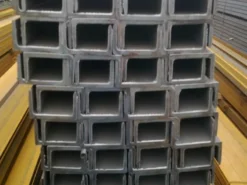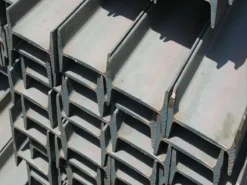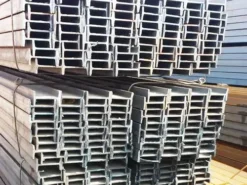Steel sheet pile is a type of steel with a lock. Its cross-sections include straight plate, groove and Z-shaped, etc., and are available in various sizes and interlocking forms. Common ones include Larson type, Lackawanna type, etc. Its advantages are: high strength, easy to drive into hard soil; it can be constructed in deep water, and if necessary, diagonal supports can be added to form a cage. It has good waterproof performance; it can form cofferdams of various shapes as needed and can be reused many times, so it has a wide range of uses.
Steel sheet pile products are divided into two types according to production technology: Cold-Formed Thin-walled steel sheet piles and Hot-Rolled Steel Sheet Piles (leading products).
(1) Cold-formed steel sheet piles include non-bite type cold-formed steel sheet piles (also called channel plates) and bite-type cold-formed steel sheet piles (divided into L-type, S-type, U-type, and Z-type) . Production process: Thin plates (commonly used thickness 8mm ~ 14mm) are continuously rolled and formed in a cold bending unit. Advantages: less investment in production lines, lower production costs, and flexible product length control. Disadvantages: The thickness of all parts of the pile body is the same, the cross-sectional size cannot be optimized, resulting in an increase in the amount of steel used, the shape of the locking part is difficult to control, the joints are not fastened tightly, and water cannot be sealed, and the pile body is prone to tearing during use.
(2) Hot-rolled steel sheet piles. Hot-rolled steel sheet piles in the world mainly include U-type, Z-type, AS-type, H-type and dozens of specifications. The production, processing and installation processes of Z-shaped and AS-shaped steel sheet piles are relatively complex and are mainly used in Europe and the United States; in China, U-shaped steel sheet piles are mainly used. Production process: It is formed by high-temperature rolling in a section steel rolling mill. Advantages: standardized size, superior performance, reasonable cross-section, high quality, and tight water-proof lock bite. Disadvantages: greater technical difficulty, higher production costs, and inflexible specification series.
Grade name:
IS A5523-SYW295: C≤0.18,Si≤0.55,Mn≤1.5,P≤0.04,S≤0.04,N≤0.006, Yield Strength>295N/mm², Tensile Strength>490N/mm², Elongation>17
SYW390: C≤0.18,Si≤0.55,Mn≤1.5,P≤0.04,S≤0.04,N≤0.006, Yield Strength>540N/mm², Tensile Strength>15N/mm²,
JIS A5528-SY295: Yield Strength>295N/mm², Tensile Strength>490N/mm², Elongation>17
SY390: Yield Strength>540N/mm², Elongation>15
-Shape Category
U Type:
1) U-shaped steel sheet piles are available in various specifications and models.
2) Designed and produced according to European standards, the structure is symmetrical, which is conducive to repeated use and is equivalent to hot rolling in terms of repeated use.
3) The length can be specially customized according to customer requirements, which brings great convenience to construction and also reduces costs.
4) Due to the convenience of production, when used with combined piles, they can be pre-ordered before leaving the factory.
5) The production design and production cycle are short, and the performance of steel sheet piles can be determined according to customer requirements.
Z Type:
1). Flexible design, with relatively high section modulus and mass ratio;
2). Higher moment of inertia, thereby increasing the stiffness of the sheet pile wall and reducing displacement and deformation;
3). Large width, effectively saving time on hoisting and piling;
4). The increased cross-section width reduces the number of shrinkage of the sheet pile wall and directly improves its water-stopping performance;
5). The parts with severe corrosion are thickened to make the corrosion resistance even better.
L Type:
The L-type is mainly used for the support of embankments, dam walls, trenching and trenching.
The cross-section is light, the pile wall takes up little space, and the locks are in the same direction, making construction easy.
Linear steel sheet piles:
Because of their low height and close to a straight line, they are more suitable for digging some trenches, especially when the space between two buildings is not large and must be excavated.










